Traction by Gino Wickman | Book Summary
In his book, Traction: Get a Grip on Your Business, Gino Wickman helps entrepreneurs implement the Entrepreneurial Operating System (EOS) to gain traction and grow their companies. Without EOS, many entrepreneurs experience at least one of these frustrations:
- Lack of Control: You are not in control of your business, as it’s in control of you.
- People: You are frustrated with your people.
- Profit: You are not making enough money.
- The Ceiling: You are stuck and grow past the ceiling.
- Nothing’s Working: You have tried everything but failed to gain traction.
This resource is just one of the many helpful business books you should read if you want to take your entrepreneurial journey to new heights.
Buy Traction on Amazon
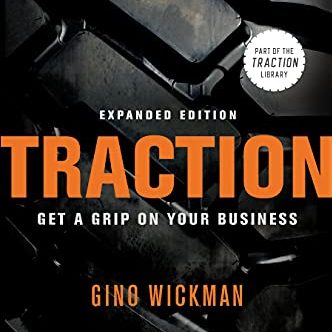
Traction by Gino Wickman
Get A Grip On Your Business
There is a small group of entrepreneurs that don’t have these frustrations. After his own business journey, Gino Wickman created EOS and wrote Traction to solve these common frustrations:
Entrepreneurial Operating System (EOS) – “a proven set of simple, practical tools that synchronizes how people in an organization meet, solve problems, plan, prioritize, follow processes, communicate, measure, structure, clarify roles, lead, and manage”
Download the Free PDF Book Summary for Traction: Get a Grip on Your Business by Gino Wickman
Chapter 1 – The Entrepreneurial Operating System: Strengthening the Six Key Components
The EOS Model is built on a core group of essential components:
The EOS Model – every business is comprised of Six Key Components that “must be managed and strengthened to create a healthy, well-run business”:
- Vision – “clearly defining who and what your organization is, where it’s going and how it’s going to get there”
- People – “getting the Right People in the Right Seats”
- Data – “using a handful of numbers that give everyone an exact pulse on where things are, and when they are off track”
- Issues – “strengthening your organization’s ability to identify issues, address them, and make them go away forever”
- Process – “systemizing your business by identifying and documenting the core processes that define the way to run your business”
- Traction – the ability for business leaders to “execute well, and they know how to bring focus, accountability, and discipline to their organization
After understanding the Six Key Components, you need to determine where your company is right now by conducting an Organizational Checkup:
Organizational Checkup – “a 20-question survey that helps measure a company’s strength in the Six Key Components”
Many companies are struggling and will score below 50 percent. The goal is to improve every 90 days and achieve over 80 percent to have implemented EOS well. Gino Wichman includes the full Organization Checkup in the book, Traction.
Chapter 2 – Letting Go of the Vine
“Most business owners are unable to reach the next level because they are simply not ready to let go of the vine.” To let go of the vine and change, you should embrace the following fundamental beliefs:
- You must establish a healthy leadership team. They should help define your corporate vision, have clear accountabilities, take initiative in their department, and fight for the great good of the company.
- You will reach an inevitable ceiling. You need to choose a leadership team that has the five core leadership abilities:
- Simply – “eliminating complexity and reducing everything to the essential”
- Delegate and Elevate – “freeing and elevating yourself to do what you do best, and doing the same for every person in your organization”
- Predict – choosing the right path in the short-term (focusing on rocks and issues within 90 days) and long-term (forecasting traction on the vision over 90 days)
- Systemize – “documenting and getting everyone to follow the essential procedural steps in your company’s core processes”
- Structure – “defining and organizing the “seats” or positions in your organization to reduce complexity and increase clarity, communication, and accountability.
- You can only run your business on one operating system. EOS is the operating system that will establish a bold vision, create alignment, set priories, foster a strong culture, and enable productivity.
- You must be willing to take risks to grow by being:
- Open-minded: Be open to new and different ideas and perspectives.
- Growth-oriented: Be willing to grow in the face of challenges and turbulence.
- Vulnerable: Be open and honest with your people by lowering your barriers.
Download the Free PDF Book Summary for Traction: Get a Grip on Your Business by Gino Wickman
Chapter 3 – The Vision Component: Do They See What You Are Saying?
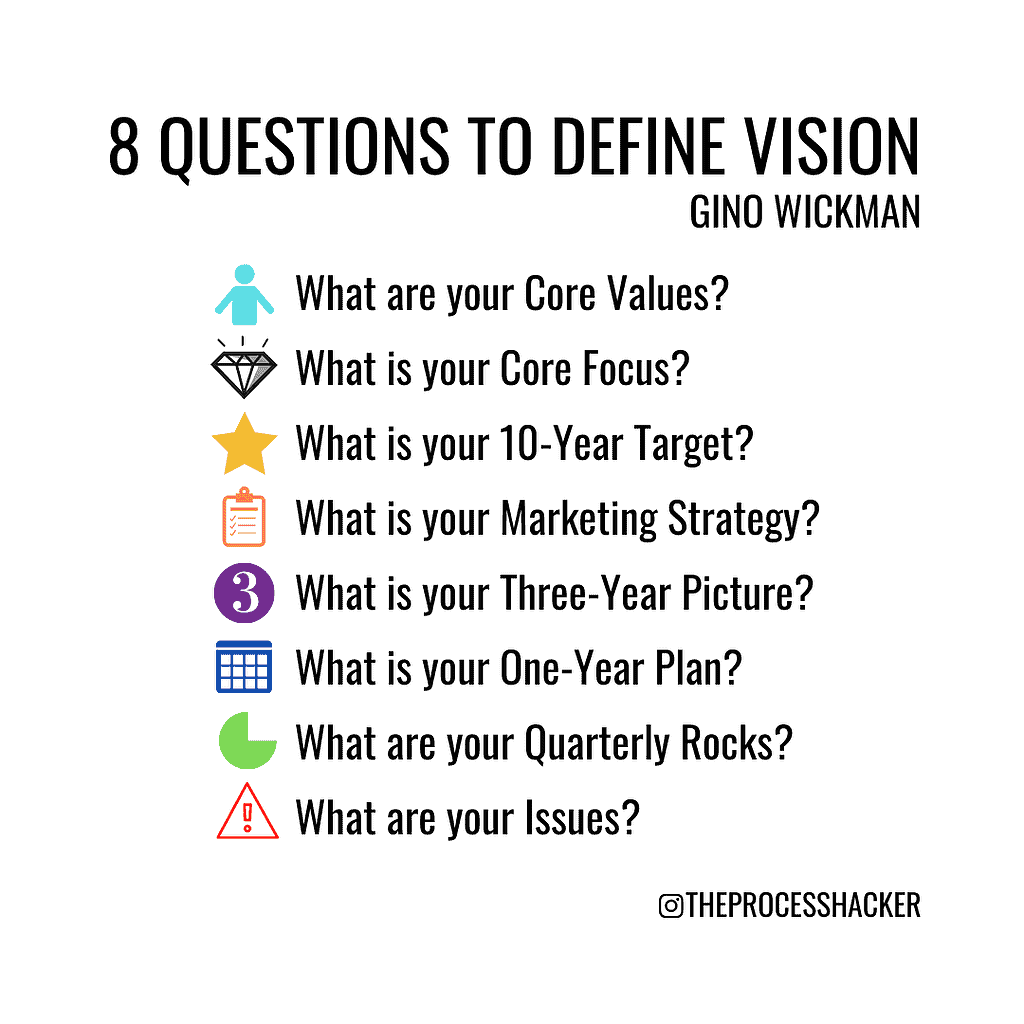
“Clarify your vision, and you will make better decisions about people, processes, finances, strategies, and customers.”
Vision Component – “clearly defining who and what your organization is, where it’s going and how it’s going to get there”
In Traction: Get a Grip on Your Business, Gino Wickman states that implementing vision involves “getting everyone in the organization 100% on the same page with where your company is going and how you’re going to get there.” With a clear vision for your business, you can make significant decisions regarding your strategies, people, customers, issues, processes, and finances.
Answering the Eight Questions
The vision should be documented in the Vision/Traction Organizer:
Vision/Traction Organizer (V/TO) – “a two-page document that helps your leadership team define, document, agree on and share the company vision;” consists of the following eight questions:
- What are your Core Values?
- What is your Core Focus?
- What is your 10-Year Target?
- What is your Marketing Strategy?
- What is your Three-Year Picture?
- What is your One-Year Plan?
- What are your Quarterly Rocks?
- What are your Issues?
(1) Core Values – “a timeless set of [three to seven] guiding principles that define your culture and the behaviors you expect from each other; they help you determine who fits your culture and who doesn’t, and they help you attract like-minded people to your team”
(2) Core Focus – “defines what you are as a company to help you avoid “shiny stuff” and keep you focused on the areas where your business excels;” derived from the intersection of knowing:
- Why does your organization exist? This is the purpose, cause, or passion of your organization captured in a three to seven word phrase that is simple, bold, and heartfelt.
- What is your organization’s niche? This is the specific product or service that you provide to your customers.
(3) 10-Year Target – “a long-range, energizing goal for the organization, ranging from five years to twenty years out;” helps help frame the shorter time-based goals for three years, one year, and quarterly
(4) Marketing Strategy – defines “your ideal customer and the most appealing message to attract them to your business; provides a laser-like focus for your sales and marketing efforts;” consists of four parts:
- Your Target Market – your ideal customers with their demographic (who they are), geographic (where they are), and psychological (what they are) characteristics
- Your Three Uniques – the specific value proposition that provides focus, makes you stand out in your niche or industry, and prevents you from trying to do too much
- Your Proven Process – the consistent way you deliver your products or services to your customers, which should be visually captured in three to seven steps
- Your Guarantee – communicates your willingness and reliability to deliver your product or service to the customer by solving issues and raising their confidence
(5) 3-Year Picture – “a definition of what your company will look like, feel like, and be like in three years; creates a powerful image of the future and helps everyone work towards the same vision.
(6) 1-Year Plan – “defines your objectives for the year by identifying and crystallizing your revenue target, profit target, and measurables, along with your top three to seven goals for the year”
(7) Rocks – “the 3 to 7 most important things you must get done in the next 90 days; employees will typically have 1-3 individual Rocks each quarter while leadership team members will typically have 3-7 individual rocks”
(8) Issues – the list of problems that will prevent you from reaching your goals; organized and documented on company-wide Issues List for transparency
The goals given above should be SMART (Specific, Measurable, Attainable, Realistic, and Timely), such that they provide clarity and set the right expectations for the work to get done. Your leadership team should discuss and debate the following metrics to set objectives for how fast you want your company to grow and how much impact you will have:
- Future Date: The due date for your company to complete this goal.
- Revenue: Amount of income generated by the sale of goods or services.
- Profit: Income remaining after the expenses are deducted from the revenue.
- Measurables: These figures indicate the scope and size of the company measured by the number of clients served, goods sold, services rendered, or widgets produced.
Shared by All
Once you have created the Vision/Traction Organizer, share it with the rest of the team to get feedback and further refine it. You and your leadership team have to communicate that vision to get buy-in from everyone. The vision can be effectively delivered to the team at three meetings:
- Company Kickoff Meeting: This event will allow you to reveal your vision to everyone with a speech and question/answer session.
- Quarterly State-of-the-Company Meeting: This recurring event should explain how the company is doing in terms of its goals and reiterate the vision to everyone.
- Quarterly Departmental Meetings: This recurring event occurs at the department level (marketing, operations, finance, etc.) and helps establish priorities.
If you are just starting out as an entrepreneur, check out Entrepreneurial Leap (book summary) by Gino Wickman. In this book, he shows you a simpler way to clarify your vision with his MyVision Clarifier tool.
Chapter 4 – The People Component: Surround Yourself with Good People

“Successful leaders surround themselves with great people. You can’t build a company without help. EOS… provides a practical understanding of the two essential ingredients of any great team: the right people in the right seats.”
People Component – “getting the Right People in the Right Seats”
In Traction: Get a Grip on Your Business, Gino Wickman states that having the right people in the right seats is essential to growing a great organization. These individuals should embody your core values, fit into the culture, and excel in positions to be effective and valuable for the company.
Right People
Right People – “the ones who share your company’s core values;” they understand the vision, fit within the company culture, and will work to make the organization better
Core Values + People Analyzer = Right People
From your Vision/Traction Organizer, you should have established your company’s core values:
Core Values – the three to seven guiding principles for who you are as an organization that help you and your people make decisions and behave for the greater good
Then, you can use the People Analyzer tool to evaluate individuals to the extent that they embody your company’s Core Values:
People Analyzer – “a simple tool that pulls your Core Values and Accountability Chart together to help your organization identify if they have the Right People in the Right Seats” using the following rating system to evaluate fit:
- Plus (+): Rating for one who mostly embodies the specific Core Value.
- Plus/Minus (+/-): Rating for one who partially represents the specific Core Value.
- Minus (-): Rating for one who rarely embodies the specific Core Value.
Evaluate each individual based on your company standards for how well they represent the Core Values. When the fit is right, your people will thrive, and your organization will be better off.
Right Seats
Right Seats – the role in which “each of your employees is operating within his or her area of greatest skill and passion inside your organization”
Unique Ability® + Accountability Chart = Right Seats
The Right Seat provides the roles and responsibilities that allow each employee to seek improvement, feel energized, and operate within their Unique Ability:
Unique Ability – an employee’s characteristics, values, and strongest skills that maximize their effectiveness and worth to the company
The Accountability Chart tool helps optimally structure an organization in terms of functionality and accountability. Further, the chart will help identify the right seats or roles that suits a given employee’s Unique Ability®:
Accountability Chart – “different from an organizational chart, an accountability chart defines the right structure for your company and clearly identifies who is accountable for what”
- Clarify roles and responsibilities so that your people are held accountable.
- Help people know who to report to and communicate with to get things done.
- Facilitate efficient decision-making and problem-solving.
- Identify all the available seats with their five to seven major roles and responsibilities.
Leadership Team – the chart helps them view their organizations differently, address people issues, and move their business forward
- Consists of a small team with three primary business functions:
- Sales and Marketing: generate business for the company
- Operations: produces the goods or services and delivers them to the customer
- Finance and Administration: manages cash flow, infrastructure, systems, and hiring
- The Leadership Team has two overarching functions that work together:
- Integrator – the leader of a company’s leadership team; they beat the drum, break the ties, harmoniously integrate other major functions in the organization, and accept ultimate accountability for achieving results”
- Visionary – “a strategic thinker who always sees the big picture and is tuned into the future of your industry;” they are typically the company’s founder, great with building relationships, and setting the culture of the organization
There is no one way to structure your organization, as the Accountability Chart can be customized. To maintain accountability, only one person should ultimately be in charge of any primary function within an organization. After establishing the Leadership Team, the primary business functions can be organized as shown below:
To fill in the structure, you need to assign three to seven major responsibilities for each role. The GWC tool helps you find the right people for the rights seats in your organization:
Get it, Want it, Capacity (GWC) – uses the following three criteria to determine determining whether the right people into the right seat for their true skill set:
- Get It: They understand the role, culture, tempo, and how it fits within the organization.
- Want It: They enjoy the role, responsibility, and compensation.
- Capacity To Do It: They have the mental, physical, and emotional ability to do the role.
Now, for a given seat or position in your organization, use the GWC tool to evaluate an individual. If you arrive at an answer of “No” to any of the three parts, then you probably do not have the right person for the right seat.
As your company grows in workload, the chart will evolve and scale to create new seats created under major business functions. Then work can be delegated down, and the right person with their Unique Ability can be assigned to the right seat using the Delegate and Elevate tool:
Delegate and Elevate – helps leaders clarify and identify the activities they must delegate to free up time; must decide the following for each task:
- Love Doing It and are Great at Doing It;
- Like Doing It and are Good are Doing It;
- Don’t Like Doing It and are Good at Doing It; and
- Don’t Like Don’t It and are Not Good at It.
Keep the task from the first two categories, and delegate the tasks in the last two categories.
After building out the Accountability Chart, you should ask these three questions to confirm that you have fully completed it:
- Do you have the right structure in place to get to the next level?
- Do you have “all of the right people in the right seats?”
- Do all your people have sufficient time to do their roles well?
Download the Free PDF Book Summary for Traction: Get a Grip on Your Business by Gino Wickman
Chapter 5 – The Data Component: Safety in Numbers
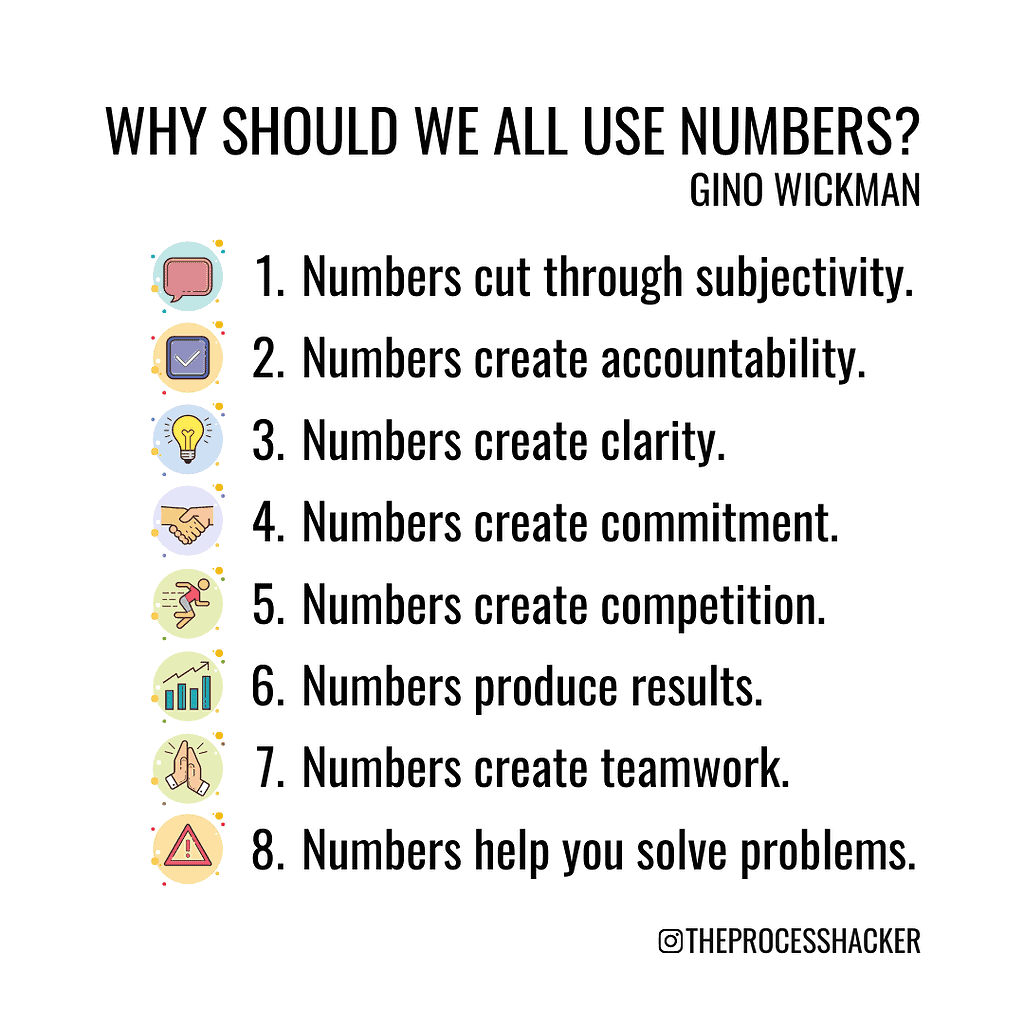
“Imagine you’re on a desert island somewhere. … All you have is a piece of paper with a handful of numbers on it. These numbers must allow you to have an absolute pulse on your business. What are all of the numbers that must be on that piece of paper?”
Data Component – “using a handful of numbers that give everyone an exact pulse on where things are, and when they are off track”
In Traction: Get a Grip on Your Business, Gino Wickman shows how data supports your company’s ability to have productive discussions and decision-making. You should run your company and respective departments using a handful of metrics to indicate the present, identify potential issues, and forecast the future. We should choose to use the data to guide our discussions and decisions instead of using assumptions, opinions, and emotions.
Scorecard
Peter Drucker has said, “What gets measure, gets managed.” You can measure parts of your business by creating a Scorecard:
Scorecard – “an EOS Tool used to track a handful of numbers that give you a pulse on your business and give you the ability to observe the present performance:
- Choose 5 to 15 “weekly activity-based numbers” or leading indicators vice lagging indicators.
- Allow you to proactively forecast, identify issues, and take action in the right direction.
- Flag categories and numbers that are off track to be aware and take corrective action.
- Will evolve as the metrics that you track can change.
The Scorecard contains the metrics or data to show performance, identify and solve problems, and remove subjectivity from communication. It should include the following:
- Who – person responsible for each of the metrics
- Measurables – the 3-5 metrics (department) or 5-15 metrics (company) that are recorded weekly on the Scorecard
- Goal – the target number that must be reached every week
- Date – the week that you are reporting on
Measurables
In EOS, everyone in the company should have something they do to contribute value to the organization that is measured consistently:
Measurables – “a single, meaningful, measurable number to guide them in their work”
Numbers provide for open communication with eight advantages to everyone having a number:
- Numbers remove subjectivity in the interactions between managers and subordinates.
- Numbers create accountability as everyone understands the expectations for their work.
- Numbers instill enthusiasm as responsible people appreciate numbers to guide them.
- Numbers create clarity and commitment when one understands their numbers and commits to achieving them.
- Numbers promote competition among individuals and teams to perform within the organization.
- Numbers produce results as the numbers that get focused on will improve over time.
- Numbers foster teamwork among individuals to work together to achieve their numbers.
- Numbers solve issues faster as they lead to proactive and objective problem-solving.
Chapter 6 – The Issues Components: Decide!
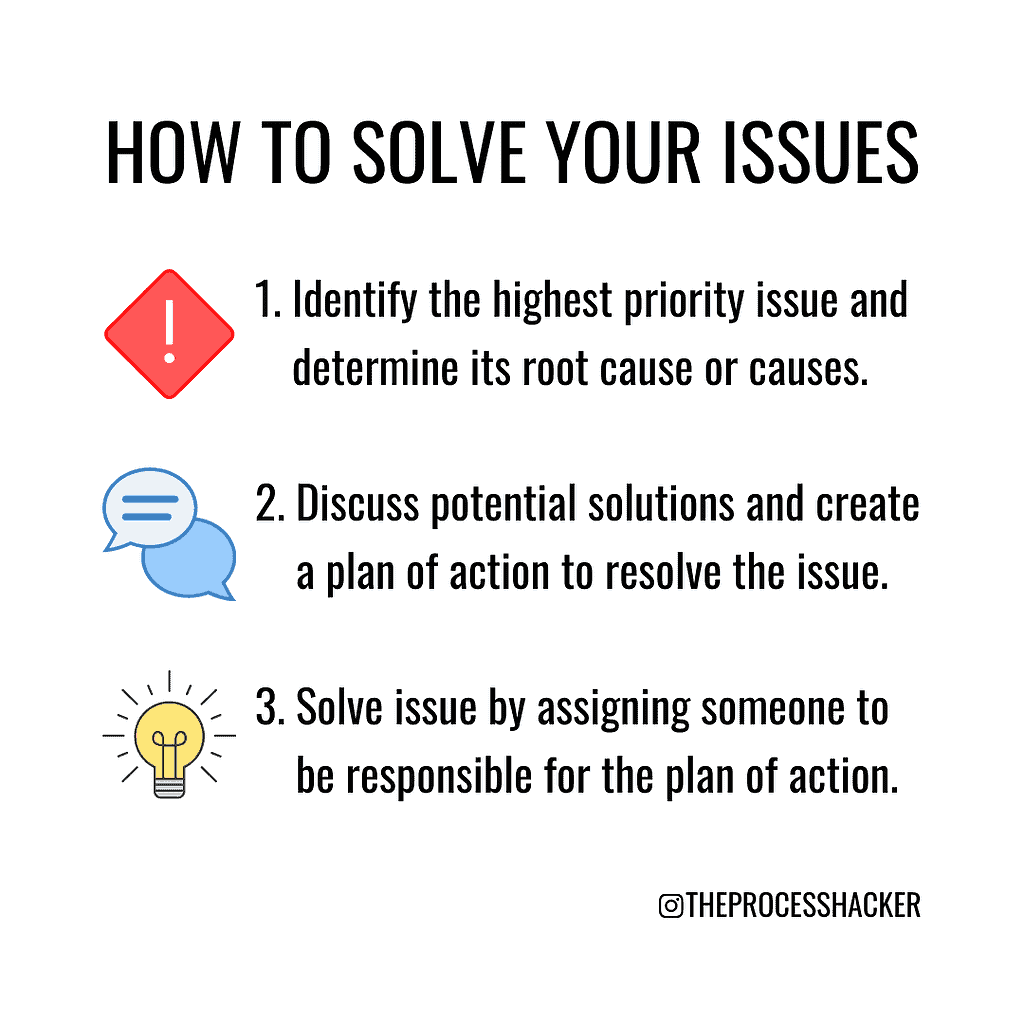
“Your ability to succeed is in direct proportion to your ability to solve your problems. The better you are at solving problems, the more successful you become.”
Issues Component – “strengthening your organization’s ability to identify issues, address them, and make them go away forever”
Issues are inherent in any business, and in Traction: Get a Grip on Your Business, Gino Wickman states that if you want to gain traction, you must foster a culture that identifies and solves problems as they arise. It feels uncomfortable to make tough decisions, as most people will procrastinate or not address their problems. The inability to take action will result in a lack of progress and may cause issues to get worse over time.
The Issues List
All businesses have issues, and through time, the same few problems reoccur. Thus, as a leader, you have to anticipate and resolve your problems using an Issues List:
Issues List – a repository to keep your problems organized in one grouping
First, you have to allow for issues to be discussed by fostering an open and honest work environment to allow issues to be uncovered and flow up to leadership. The problems can then be organized into one of these Issues Lists to promote transparency and solve the problems:
- Vision/Traction Organizer (V/TO) Issues List: These high-level company-wide issues do not have to be solved immediately can be resolved during future quarterly meetings.
- Weekly Leadership Team Issues List: These high-level company-wide issues have to be dealt with more immediately and can be resolved during weekly leadership meetings.
- Departmental Issues List: These local-level issues can be pushed down to the department level and resolved during weekly departmental meetings.
Issues Solving Track (IDS)
Instead of talking in circles around your problem and never get to solving them, you should resolve issues in a simple, timely, and efficient way using the Issues Solving Track:
Issues Solving Track (IDS) – “the process your team uses to Identify, Discuss, and Solve issues on an ongoing basis:”
- Identify the three most important issues and prioritize them. Remember, if you think that everything is important; then, nothing is important. Next, your team should dive deep and distinguish the root cause, which can be written in a concise problem statement.
- Discuss the potential solutions and create a plan of action to resolve the issues. Many people get stuck as they spend a lot of time in discussion and never get to solving. If your team successfully identified the issue, the answer will likely be clear and obvious.
- Solve the issues using the plan of action and assign someone to be responsible for each item. The team will create an action item on a to-do list. The responsible person will execute and complete the task, and the issue is finally resolved.
Issues are usually solved in one of three ways:
- The issue gets solved in the meeting, and someone executes on the action item.
- The issue is a lack of awareness in the team and is solved by notifying everyone.
- The issue requires more information to solve, so someone is assigned to conduct the research and present the results at a follow-up meeting.
Wickman provides ten rules to help teams solve issues using the Issues Solving Track:
10 Commandments of Solving Issues – help teams prioritize and resolve problems effectively, decisively, and for the greater good of the company:
- Do Not Rule by Consensus: When your team does not agree upon a solution, do not make decisions by majority rule. You or the person with the designated authority needs to decide for the team.
- Have a Strong Will and Resolve: Sometimes, the solution will be complicated, and you have to do what it takes to make the decision.
- Be Decisive: You need to make decisions quickly with the understanding that you can make adjustments during execution.
- Do Not Rely on Secondhand Information: When solving issues, make sure that all the relevant people are involved in decision-making.
- Fight for the Greater Good: Teams can get burdened by emotions, egos, fear, and lack of focus, so it is important to rise above that for the prosperity of the organization.
- Solve Issues in Order of Priority: There will always be a new problem to solve that gets added to a never-ending list. Therefore, you solve issues by order of importance.
- Resolving in Three Ways: When it comes to solving issues, you can either live with it, change it, or solve the issue. Living with a problem should be the last possible option.
- Choose Short-Term Pain for Long-Term Gain: You should work to solve your issues as soon as possible due to the sustained impact they can have on your business.
- Take on the Most Fearful Issue: Sometimes, you need to take on the issue that scares you the most. We grow the most in uncomfortable situations.
- Don’t Wait and Propose a Solution: Someone needs to take a chance and introduce a solution to orient the rest of the team to decide on a solution.
It can be challenging to create an open and honest environment. The lack of transparency can stem from individuals not getting along, so it may be helpful to have an issues solving session.
Download the Free PDF Book Summary for Traction: Get a Grip on Your Business by Gino Wickman
Chapter 7 – The Process Component: Finding Your Way
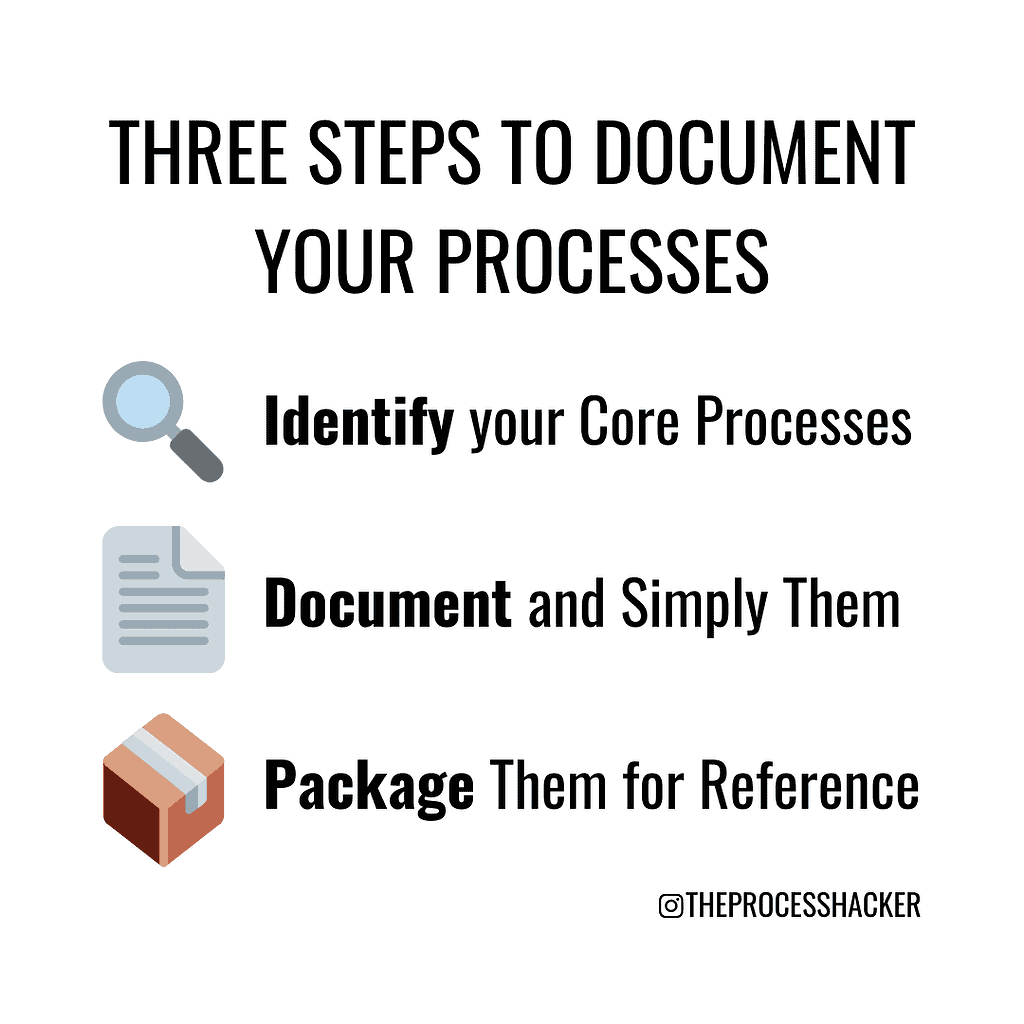
“When everyone follows their process, it’s much easier for managers to manage, troubleshoot, identify and solve issues, and therefore grow the business. The clear lines of process enable you to let go and gain more control.”
Process Component – “systemizing your business by identifying and documenting the core processes that define the way to run your business”
In Traction: Get a Grip on Your Business, Gino Wickman shows you how processes are powerful and can result in simplifying, scaling, and productivity. Your business should be run through a handful of core processes that work together to be the system that is your business:
Process – a series of actions or steps taken to achieve a particular end
Processes provide your people with the ability to be consistent in their actions. Everyone in your organization should understand the processes, value them, and follow them. Consistent action over time will result in the growth, durability, and scaling of the organization.
Documenting Your Core Processes
You can document your core process using the 3-Step Process Documenter:
3-Step Process Documenter – helps you systematize processes for your people to have more control and freedom over their work; consists of the following three steps:
- Identify the handful (about seven) of core processes that capture all the activities in the organization. The leadership team should name each process to provide, reduce complexity, and improve productivity. These are common examples of core processes:
- HR – “the way you search, find, hire, orient, manage, review, promote, retain, and fire people”
- Marketing – “the way you get your message to your target audience and generate interest in what you do and prospects for your salespeople”
- Sales – “the way you convert a prospect into a customer”
- Operations – “the way you make your product or provide your service to your customer;” often include project management, customer service, and fulfillment
- Accounting – “the flow and management of all monies coming in and going out”
- Customer-retention – the proactive way that retains customers after product or service delivery and seeks referrals
- Document core processes using the 80/20 rule, which means that 20% of documentation should capture 80% of the ideas and steps for that specific process. When capturing the process, look to simplify, remove redundancy, eliminate confusion, and add checklists.
- Package the core processes into a handbook, which can be used for reference and training. The package booklet or electronic document can be section by core processes. Then, everyone in your organization can be trained on the core processes and have access to the booklet for reference.
Followed by All
When everyone in the company follows the core processes, managers can manage their people, resolve issues, and grow the business. The business becomes less complicated and more manageable to scale to handle more customers, revenue, and employees.
The leadership team can get buy-in from their employees by taking the following action steps:
- Create your Circle of Life visual to show how the core processes are related.
- Share the processes during the next company meeting or the next quarterly company meeting.
- Retrain everyone to follow the processes.
- Manage your people to follow the processes and work within the system.
Chapter 8 – The Traction Component: From Luftmensch to Actions!

“The traction side of the V/TO, which is about bringing your long-range vision down to the ground and making it real. That means deciding on what must get done this year.”
Traction Component – the ability for business leaders to “execute well, and they know how to bring focus, accountability, and discipline to their organization
In Traction: Get a Grip on Your Business, Gino Wickman emphasizes that the most important thing is to take consistent action toward your vision. Many people have great ideas; however, most people never take action on vision and their “great” ideas. And thus, gaining traction is making our vision a reality by doing the 10X action steps that will move you toward your vision. It may feel uncomfortable to hold your organization and people responsible and accountable, but growth happens in times of uncomfortably.
Rocks
Rather than being overwhelmed by the vision, the 90-Day World is powerful as it allows you to break it down for your people to accomplish in manageable chunks, known as Rocks:
Rocks – “the 3 to 7 most important things you must get done in the next 90 days; employees will typically have 1-3 individual Rocks each quarter while leadership team members will typically have 3-7 individual rocks”
Rocks should be SMART (Specific, Measurable, Attainable, Realistic, and Timely) to provide clarity, get organized, and set the right expectations for the work to get done. In Start Finishing, Charlie Gilkey provides his SMART framework to take our ideas and frame them as SMART goals:
- Simple – “help you know exactly what you need to do to move forward with the idea”
- Meaningful – provides you with a quick understanding of “the importance of completing that goal”
- Actionable – tells you “what action needs to be taken to accomplish that goal”
- Realistic – shows you that “the endpoint is achievable with the resources you have available”
- Trackable – tells you clearly “what progress means,” qualitatively or quantitatively; needs to establish start and end dates, or it will not happen
When setting SMART rocks, you should keep in mind the following:
- Setting the wrong priorities and rocks will move the organization in the wrong direction.
- It takes about two quarters to become proficient in setting solid priorities and rocks.
- Commit firmly to taking action on and achieving your rocks in that respective period.
- Don’t set too many rocks, as you might be overwhelmed and unmotivated in the process.
Meeting Pulse
The purpose of conducting these meetings is to induce your people to take action on specific deliverables for the next meeting through the natural Meeting Pulse:
Meeting Pulse – the action of holding meetings that are consistent and effective to increase traction, communication, and accountability
People tend to procrastinate on work, so the meeting provides a due date and time for work to get done. Meetings also allow for enhanced communication, accountability, and discipline. Over time, the consistent action taken by your people will result in gaining traction on our vision.
There are two major leadership meetings, which should be offsite and scheduled in advance:
- Quarterly Meetings: The quarterly meeting is a full-day offsite meeting for the leadership team to establish the organization’s priorities for the next quarter.
- Annual Meeting: This offsite retreat is two or more days for the leadership team to plan the year, improve upon the vision, and foster relationships within the leadership team.
Traction requires taking the vision and executing on a weekly basis with the Level 10 Meeting:
Level 10 Meetings – “a weekly meeting with a specific agenda designed to help you stay focused on what’s important, solve issues effectively, and keep your team connected”
Every week, there should be a regular 90-minute meeting within the leadership and departments to review measurables and rocks, discuss employee and customer satisfaction, and solve problems. These meetings should follow the Level 10 Meeting format:
- Introduction: The meeting starts on time, and everyone should be there.
- Positive Stories: Have a few people share big personal or professional wins.
- Scorecard: Review the datasheet to see that the company or department is on track.
- Rock Review: Review rocks to see who is tracking to achieving them.
- Customer or Employee News: Share significant news from your people or customers.
- To-Do List: Review all the to-do or seven-day tasks from the previous week’s meeting.
- Issues: Identify the major issues, discuss solutions, and resolve them.
- Conclusion: Recap the significant aspects of the meeting and end on time.
Chapter 9 – Putting It All Together: The Grand Journey
When you implement the Six Key Components of the EOS® Model in your business, you will be able to manage and strengthen your business to establish a healthy, well-run business. It is recommended that you do an Organizational Checkup twice a year to assess and measure a company’s capacity in the Six Key Components using a 20-question survey.
Download the Free PDF Book Summary for Traction: Get a Grip on Your Business by Gino Wickman
Chapter 10 – Getting Started
In Traction: Get a Grip on Your Business, Gino Wickman lists the seven primary (and 12 secondaries) tools in the EOS system. These tools are put in the order of recommended implementation:
- Accountability Chart
- Rocks
- Meeting Pulse
- Scorecard
- Vision/Traction Organizer (V/TO)
- Three-Step Process Documenter
- Measurables
Next Steps: Check out Traction by Gino Wickman
In his book, Traction: Get a Grip on Your Business, Gino Wickman helps entrepreneurs implement the Entrepreneurial Operating System to gain traction and grow their companies. I hope this blog post has inspired you to get your copy of Traction by Gino Wickman or check out the rest of the EOS library:
- Get a Grip: How to Get Everything You Want From Your Entrepreneurial Business (book summary and pdf free download): Tells a fictional business fable about an entrepreneurial company hitting the ceiling. In response, the company’s leadership implements EOS for success.
- Rocket Fuel (book summary): Provides a guide for the integral relationship between a Visionary and an Integrator.
- How to Be a Great Boss (book summary): Helps leaders and managers at all levels of an organization get the most from their people.
- What the Heck is EOS? (book summary): Provide a complete and simplified guide on the EOS process and tools for your employees.
- The EOS Life: How to Live Your Ideal Entrepreneurial Life (pdf book summary): Live your ideal life “doing what you love, with people you love, making a huge difference, being compensated appropriately, with time for other passions.”
- Process (book summary): Helps you document, simply, and package your core processes such that they are followed by all in your organization.
- Entrepreneurial Leap (book summary): Helps you determine if you are an Entrepreneur-in-the-making, take the Entrepreneurial Leap, and become an entrepreneur.


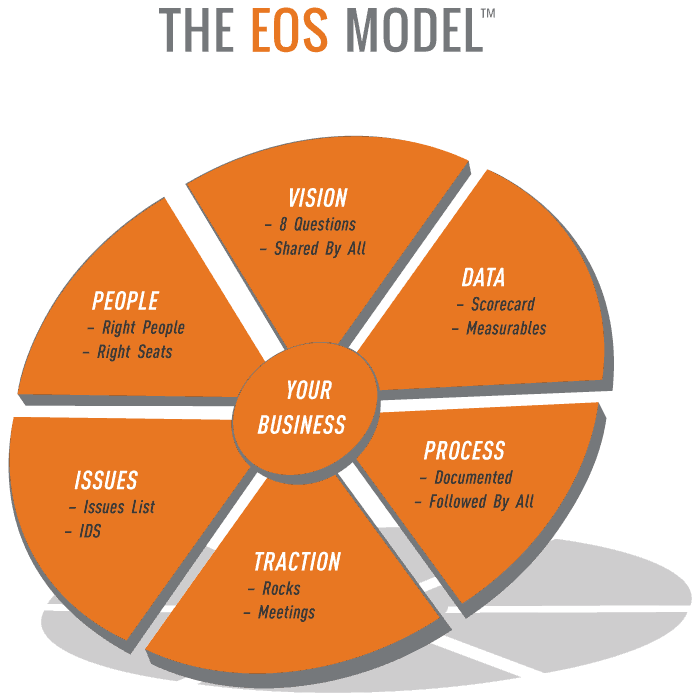
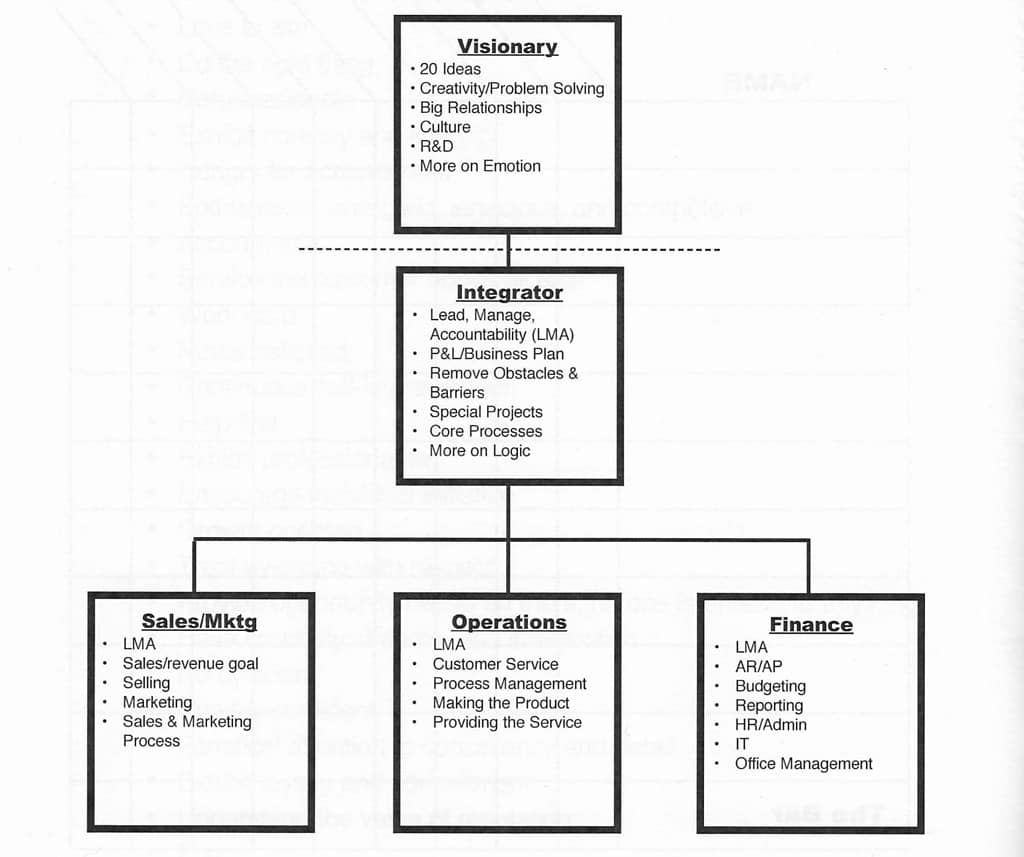

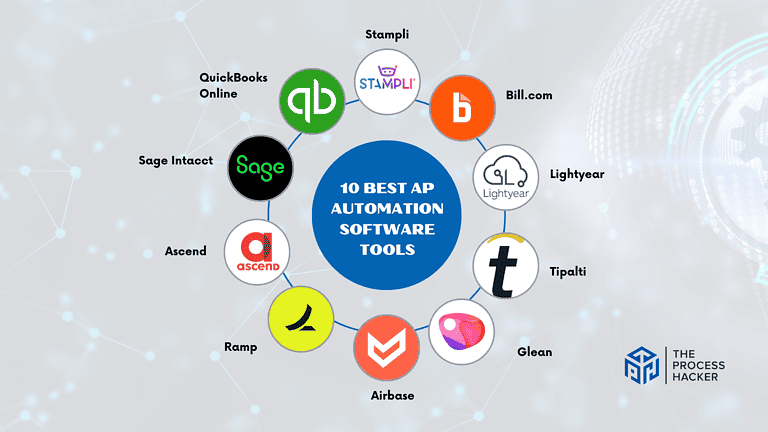




A lot of fellow business owners have benefitted from implementing Traction. In my mind it seems that this model translates the leanest version of how a larger business operates into something smaller companies can utilize.
I always enjoy your summaries. They are concise and do a nice job of giving valuable pieces of information for us to read. Thank you for your hard work.